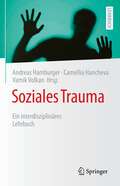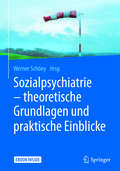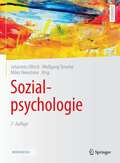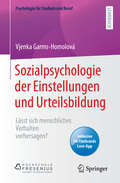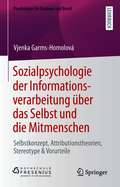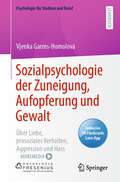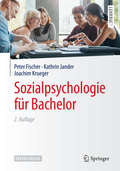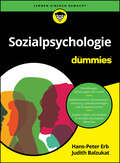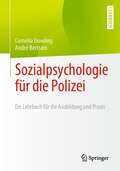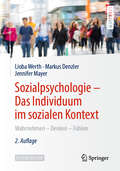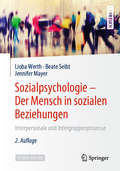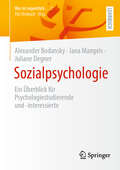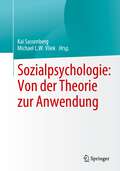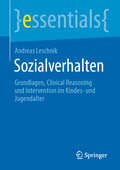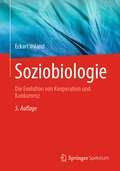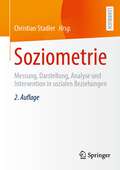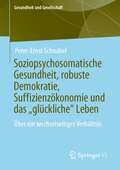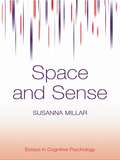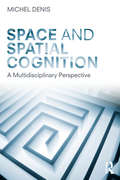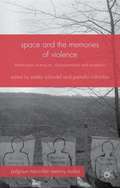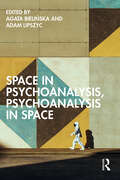- Table View
- List View
Soziales Trauma: Ein interdisziplinäres Lehrbuch
by Andreas Hamburger Camellia Hancheva Vamık VolkanDas interdisziplinäre Lehrbuch zum Sozialen Trauma schließt eine Lücke zwischen klinischen und sozialwissenschaftlichen Traumatheorien und bietet Grundlagen für die universitäre Lehre sowie einen Überblick für alle, die sich mit Opfern sozialer Gewalt befassen. International führende Expert*innen skizzieren konzeptionelle Ansätze, Behandlungsmethoden und Forschungsstrategien zum Verständnis sozialer Traumatisierungen (kollektive Gewalt, Verfolgung, Folter und Zwangsmigration) in einem breiteren Spektrum von Ansätzen, das sowohl die Klinische Psychologie als auch die Psychiatrie, Sozialpsychologie, Entwicklungspsychologie, Kulturwissenschaften, Politologie, Recht, spezifische Forschungsmethodiken, Ethik und Didaktik umfasst. Das Buch, das aus einem zehnjährigen interdisziplinären und internationalen Dialog hervorgegangen ist, bietet somit eine nützliche Referenz.
Sozialismus mit menschlichem Antlitz: Die Anwendung von Verhaltensökonomie zur Erforschung der wirtschaftlichen Geschichte in Ostdeutschland
by Wayne Geerling Gary B. MageeDie Wirtschaftsgeschichte Ostdeutschlands wird in der Regel als eine Geschichte des Zusammenbruchs eines von Natur aus fehlerhaften Systems erzählt. Doch obwohl die Ineffizienz des Systems unbestreitbar ist, war seine Wirtschaftsgeschichte viel reicher, als seine vergleichsweise schlechte Wirtschaftsleistung vermuten lässt. Für viele, die dort lebten, war es ein System, das in den vierzig Jahren seines Bestehens zu Leistungen fähig war und im Allgemeinen auf einem erträglichen Niveau funktionierte. Dieses Buch kombiniert die Erkenntnisse der Verhaltensökonomie mit Archivrecherchen, um die Schichten der Rhetorik und der Annahmen über die ostdeutsche Wirtschaft abzuschälen und Aspekte der zugrunde liegenden Funktionalität zu untersuchen. Anhand einer Reihe von Fallstudien, die die Einrichtung sozialistischer Arbeitsplätze, das Streben nach Produktivitätssteigerung und Effizienz sowie die Entstehung der Finanzkrise untersuchen, betrachtet das Buch das System aus der Perspektive der Menschen, die es betrieben und die Entscheidungen trafen, die es zum Funktionieren brachten. Unbelastet von politischen Vorurteilen bietet es ein realistischeres Verständnis der ostdeutschen Wirtschaftsgeschichte als dasjenige, das sich aus festgefahrenen Debatten über den Zusammenprall der Systeme ergibt. Die vorgestellten neuen Perspektiven und Ansätze zeigen, dass die ostdeutsche Wirtschaftsgeschichte, herausgelöst aus ihrem Kontext des Kalten Krieges, als das analysiert werden kann, was sie war, und nicht als das, was sie symbolisierte.
Sozialpsychiatrie – theoretische Grundlagen und praktische Einblicke
by Werner SchönyDieser Überblick über die Sozialpsychiatrie als wissenschaftliche Disziplin stellt das komplexe Thema „psychische Krankheit und Gesundheit“ in seiner gesamten Vielfalt und Weitläufigkeit dar. Es geht darum, die Sozialpsychiatrie aus unterschiedlichen Perspektiven - inklusive ihrer Traditionen und Widersprüchlichkeiten – zu betrachten und praktische Einblicke zu geben.Der InhaltBegriff, Themen und GeschichteGesellschaftstheoretische und normative GrundlagenUrsachenbezogene und epidemiologische ForschungVersorgungs- und Wirkungsforschung Präventive und soziologische DisziplinTrends und Herausforderungen
Sozialpsychologie
by Wolfgang Stroebe Miles Hewstone Johannes UllrichWarum verhält sich jemand aggressiv? Wieso helfen viele Zuschauer bei einem Unfall nicht? Soll ich aufhören zu rauchen, weil es meiner Gesundheit schadet? Wie bildet sich ein Gruppenanführer heraus? Das alles ist Sozialpsychologie! Das vielseitige Fachgebiet beschäftigt sich damit, wie Gedanken, Gefühle und Verhalten von Individuen durch die tatsächliche oder vorgestellte Anwesenheit anderer Menschen beeinflusst werden. Lesen und Lernen mit ausgefeilter Didaktik: Aus der Forschung, Pioniere, Sozialpsychologie im Alltag Deutsch-englisches Glossar Mit interaktiver Lernwebsite: Lernkarten, Quiz, Prüfungsfragen, Links, Materialien für Dozenten
Sozialpsychologie der Einstellungen und Urteilsbildung: Lässt sich menschliches Verhalten vorhersagen? (Psychologie für Studium und Beruf)
by Vjenka Garms-HomolováDieses Lehrbuch der Sozialpsychologie erklärt alltagsnah und kompakt, wie wir die Beweggründe unserer Mitmenschen durchschauen und ihr Verhalten vorhersagen können. Oder wissenschaftlich ausgedrückt: Was sind Einstellungen, welche Bedeutung haben sie für die Vorhersage unseres Verhaltens in Berufs- und Privatleben und welche Wege zur Änderung von Einstellungen gibt es?
Sozialpsychologie der Informationsverarbeitung über das Selbst und die Mitmenschen: Selbstkonzept, Attributionstheorien, Stereotype & Vorurteile (Psychologie für Studium und Beruf)
by Vjenka Garms-HomolováDieses Sozialpsychologie-Lehrbuch erklärt alltagsnah und kompakt, wie wir uns aus dem sozialen Kontext Informationen beschaffen, um die eigene Person - das Selbst - und unsere Mitmenschen zu verstehen. Sozialpsychologisch ausgedrückt heißt es: Wie entsteht unser Selbstkonzept, was sind Attributionstheorien und wie entwickeln sich Stereotype, Vorurteile oder sogar die Stigmatisierung bestimmter Personen?
Sozialpsychologie der Massenbildung: 100 Jahre Sigmund Freuds "Massenpsychologie und Ich-Analyse" (Kritische Sozialpsychologie)
by Julia König Markus Brunner Hans-Dieter König Jan LohlDie Aktualität von Freuds Massenpsychologie, von der das Projekt der analytischen Sozialpsychologie ausgegangen ist, zeigt sich an Phänomenen wie dem Rechtspopulismus und den Querdenker:innen, die auch durch die sozialen Medien massenwirksam werden. Die Beiträge dieses Sammelbandes verorten Freuds Massenpsychologie in verschiedenen historischen Kontexten, erörtern unterschiedliche systematische Aspekte seiner Theorie und illustrieren, wie sich von dieser Studie her empirische Projekte konzipieren und Forschungserträge auswerten lassen.
Sozialpsychologie der Zuneigung, Aufopferung und Gewalt: Über Liebe, prosoziales Verhalten, Aggression und Hass (Psychologie für Studium und Beruf)
by Vjenka Garms-HomolováDieses Lehrbuch der Sozialpsychologie erklärt alltagsnah und kompakt die ganze Bandbreite zwischenmenschlicher Beziehungen: Warum finden Menschen einander attraktiv und gehen Beziehungen ein? Warum helfen Menschen oder opfern sich gar für andere auf? Wie entstehen Aggressionen oder gar Hass? Diese Themen der Sozialpsychologie sind brandaktuell, wie die Diskussionen um Aggression im Internet und Hassphänomene zeigen.
Sozialpsychologie für Bachelor (Springer-Lehrbuch)
by Peter Fischer Kathrin Jander Joachim KruegerIn dem Buch sind die prüfungsrelevanten Themen des Grundlagenfachs Sozialpsychologie, inklusive aktueller Trends wie positive Psychologie und soziale Neurowissenschaften, lerngerecht aufbereitet: mit Fallbeispielen, Definitionen, Studienboxen, Exkursen und Kontrollfragen. Auf der begleitenden Website stehen mp3-Hörbeiträge, Lerntools und Vorlesungsmaterialien für Dozenten zum Download bereit. Für Studierende im Bachelorstudium und alle, die einen leicht verständlichen Einstieg in die Sozialpsychologie suchen.
Sozialpsychologie für Dummies (Für Dummies)
by Hans-Peter Erb Judith BalzukatDer Mensch als soziales Wesen Sie möchten sich selbst und andere Menschen als soziale Wesen genauer kennenlernen? Sie möchten sich einen Überblick über die Sozialpsychologie verschaffen? Hans-Peter Erb und Judith Balzukat betrachten in ihrem Buch Denken, Fühlen und Handeln im sozialen Kontext. Sie erklären überaus anschaulich, wie wir Menschen Urteile bilden, Einstellungen entwickeln oder andere sympathisch finden. Mit diesem Buch erhalten Sie eine umfassende Übersicht zu sozialpsychologischen Erkenntnissen und zugleich Einblicke in Ihr eigenes alltägliches Verhalten und die Reaktionen Ihrer Mitmenschen auf Sie. Sie erfahren Welche Theorien und Methoden der Sozialpsychologie Sie unbedingt kennen sollten Wie Gedanken, Gefühle und Verhalten von anderen Menschen beeinflusst werden Wissenswertes über Gruppenprozesse, soziale Identität und Vorurteile
Sozialpsychologie für die Polizei: Ein Lehrbuch für die Ausbildung und Praxis
by Cornelia Dowling André BertramDieses Lehrbuch bietet einen verständlichen Überblick über die Themen der Sozialpsychologie für die Ausbildung und Berufspraxis der Polizei. Insbesondere kann es zu Rate gezogen werden, wenn es im Polizeialltag darum geht, schnell und unter Unsicherheit Personen und Situationen zu beurteilen, angemessen auf Provokationen zu reagieren, effizient in Gruppen und Teams zusammenzuarbeiten, bei Fremdgruppen gefährliche Gruppenprozesse vorherzusehen und kompetent beim Umgang mit Konflikten zu sein. Umfangreiche Forschungsergebnisse der Sozialpsychologie zu all diesen Herausforderungen werden im Buch mit Sachverhalten aus dem Polizeialltag illustriert und so verständlich gemacht.
Sozialpsychologie – Das Individuum im sozialen Kontext: Wahrnehmen – Denken – Fühlen
by Lioba Werth Jennifer Mayer Markus DenzlerDieses Lehrbuch bietet einen kompakten und leicht verständlichen Überblick über das Fach Sozialpsychologie für Studium und Beruf. In diesem Band erfahren Sie, wie Menschen denken und fühlen, wie sie zu Urteilen und Entscheidungen kommen, welche Faktoren bestimmen, wie sie von anderen Menschen wahrgenommen werden, welche Rolle das Selbst beim Erleben und Verhalten spielt und wodurch Einstellungen geformt werden und wie diese mit Verhalten zusammenhängen. Das Lehrbuch führt in die Sozialpsychologie ein und erfordert daher keine Vorkenntnisse. Anhand vieler Beispiele werden zentrale Begriffe und Befunde erklärt. Es richtet sich an alle Studierenden, deren Studiengang sozialpsychologische Themen behandelt. Doch nicht nur für die Prüfungsvorbereitung, sondern auch für die Arbeit mit Menschen, beispielsweise in den Bereichen Gesundheit, Bildung, Wirtschaft, bietet es ein gutes Grundgerüst: Sie möchten das eigene Erleben und Verhalten und das anderer Menschen besser verstehen? Die Autoren erklären anschaulich, wie Erleben und Verhalten durch Kontexte und Situationen beeinflusst werden. Zusätzlich finden Sie Begleitmaterial auf der Lehrbuch-Webseite.
Sozialpsychologie – Der Mensch in sozialen Beziehungen: Interpersonale und Intergruppenprozesse
by Lioba Werth Beate Seibt Jennifer MayerDieses Lehrbuch bietet einen kompakten und leicht verständlichen Überblick über das Fach Sozialpsychologie für Studium und Beruf. In diesem Band erfahren Sie, wie Beziehungen funktionieren, wodurch die Zusammenarbeit in Gruppen geprägt ist, wie Sie durch Gruppendruck und andere Strategien beeinflusst werden, wie Vorurteile entstehen, was Hilfsbereitschaft, aber auch was Aggression fördert. Das Lehrbuch führt in die Sozialpsychologie ein und erfordert daher keine Vorkenntnisse. Anhand vieler Beispiele werden zentrale Begriffe und Befunde erklärt. Es richtet sich an alle Studierenden, deren Studiengang sozialpsychologische Themen behandelt. Doch nicht nur für die Prüfungsvorbereitung, sondern auch für die Arbeit mit Menschen, beispielsweise in den Bereichen Gesundheit, Bildung, Wirtschaft, bietet es ein gutes Grundgerüst: Sie möchten Teamarbeit verbessern? Beziehungsmuster verstehen? Aggression abbauen? Kooperation fördern? Die Autorinnen erklären anschaulich, wie Erleben und Verhalten durch Kontexte und Situationen beeinflusst werden. Zusätzlich finden Sie Begleitmaterial auf der Lehrbuch-Webseite.
Sozialpsychologie: Ein Überblick für Psychologiestudierende und -interessierte (Was ist eigentlich …?)
by Juliane Degner Jana Mangels Alexander BodanskyDieses Buch ist als Einstieg in die Sozialpsychologie und deren Wissen, Methoden und Denkweisen angelegt. Es greift dabei verschiedene alltägliche Situationen auf und erklärt typische Wahrnehmungen, Gedanken, Gefühle und Verhaltensweisen, die Menschen in diesen Situationen zeigen. Dadurch wird ein Einblick in grundlegende sozialpsychologische Theorien ermöglicht. Die Lesenden erfahren, wie menschliches und damit auch das eigene Verhalten durch die soziale Natur des Menschen geprägt ist und wie dieses Wissen potenziell genutzt werden kann, um Menschen ein besseres Miteinander zu ermöglichen. Das Buch richtet sich dabei an Menschen ohne bisherige Vorerfahrung in diesem Gebiet und soll zu einer weiteren Auseinandersetzung mit sozialpsychologischen Themen anregen und zur praktischen Nutzung sozialpsychologischen Wissens motivieren.
Sozialpsychologie: Von der Theorie zur Anwendung
by Kai Sassenberg Michael L. W. VliekDieses aktuelle und anwendungsorientierte Lehrbuch bringt führende Wissenschaftler zusammen, um zu veranschaulichen, wie wichtige Theorien und Konzepte der Sozialpsychologie helfen, Verhalten vorherzusagen und zu erklären, und wie sie erfolgreich auf soziale und praktische Probleme angewendet werden können. Es konzentriert sich auf robuste Theorien und Modelle, die für ihre erfolgreiche Anwendung bekannt sind, und deckt ein breites Spektrum von Bereichen ab - von Interventionen im Klassenzimmer über Gesundheitsverhalten und finanzielle Entscheidungsfindung bis hin zum Klimawandel und vieles mehr. Jedes Kapitel besteht aus einem theoretischen Teil, in dem die Schlüsselkonzepte definiert und die Theorie zusammengefasst werden, sowie aus einem Anwendungsteil, der die Forschung in einem angewandten Kontext zusammenfasst und Details zu einer bestimmten Studie einschließlich des jeweiligen Anwendungsumfelds liefert. Das Lehrbuch zeigt fachkundig, wie die Theorie sinnvolle Vorhersagen für reale Kontexte machen kann, und scheut sich nicht, die potenziellen Hürden und Fallstricke bei der Anwendung einer Theorie und der ihr zugrunde liegenden Konzepte in einem bestimmten Kontext zu erläutern. Entscheidend ist, dass dieses Format auf die Überprüfung der Theorie in angewandten Kontexten abzielt und eine genauere Untersuchung der Gründe und Umstände ermöglicht, warum und unter welchen Umständen Interventionen erfolgreich sein können, um einen gewünschten Verhaltens- oder psychologischen Endzustand zu erreichen. Zu den untersuchten Themen gehören: Mindset-Theorie der Handlungsphasen und Wenn-dann-Planung Qualität der Motivation in der Selbstbestimmungstheorie Die Fokustheorie des normativen Verhaltens Theorie der sozialen Identität und Theorie des Kontakts zwischen Gruppen Gruppenübergreifende Vergebung Social Psychology in Action ist ein wichtiges Hilfsmittel für fortgeschrittene Studenten der Sozial- und Kulturpsychologie sowie für Studenten der Verhaltensökonomie, die ein tieferes Verständnis der wichtigsten Theorien und Anwendungen dieser Bereiche entwickeln möchten. Praktiker, die in den Bereichen Organisationsverhalten und -management, Gesundheitskommunikation, Sozialarbeit sowie Erziehungswissenschaft und Pädagogik tätig sind, werden das Buch ebenfalls als relevant für ihre Arbeit empfinden.
Sozialverhalten: Grundlagen, Clinical Reasoning und Intervention im Kindes- und Jugendalter (essentials)
by Andreas LeschnikIn diesem essential werden die Grundlagen des Sozialverhaltens erklärt. Außerdem gibt es einen kurzen Überblick über die kindliche Entwicklung des Sozialverhaltens. Im weiteren Verlauf wird das hypothetisch-deduktive Clinical Reasoning zum Erstellen einer therapeutischen Diagnose bei Kindern und Jugendlichen mit Störungen des Sozialverhaltens eingesetzt. Am Ende bietet dieses essential Interventionsmöglichkeiten für Kinder und Jugendliche mit Störungen des sozialen Verhaltens.
Soziobiologie: Die Evolution von Kooperation und Konkurrenz
by Eckart VolandSoziobiologie ist den evolutionsbiologischen Ursprüngen und Gründen tierlichen und menschlichen Sozialverhaltens auf der Spur. In diesem Buch werden Strategien sozialer Konkurrenz, also Gewalt, Kampf und Dominanz behandelt, aber auch Kooperation, Altruismus und Solidarität. Die Interessen der beiden Geschlechtern sind Treibstoff der sexuellen Selektion. Kooperation ist also immer auch brüchiger Kompromiss im Kampf der Geschlechter zu verstehen. Außerdem geht es um die neuesten Erkenntnisse zur Evolution der Eltern/Kind-Verhältnisses und um ein Brutpflegeverhalten, das Kindesvernachlässigung und zugleich auch tief empfundene elterliche Zuneigung und Fürsorge möglich macht. Beschrieben wird, wie eine evolutionäre Perspektive auf das menschliche Verhalten zum modernen Menschenbild beiträgt. Das Buch richtet sich an Studierende und Lehrende der Biologie, Anthropologie, Psychologie und Sozialwissenschaften und an alle an der evolutionären Geschichte des menschlichen Sozialverhaltens Interessierte.
Soziodrama in der Organisationsentwicklung: Essentials für die Praxis
by Matthias Bongartz Uwe Reineck Christoph BuckelVeränderung zum Anfassen, Beteiligung zum Leben erwecken, Lösungen hautnah erlebenOrganisationsentwicklung bedeutet mehr als Strukturen zu verändern – sie ist Dialog, Reflexion und gemeinsames Lernen. Organisationen reflektieren, indem ihre Mitglieder miteinander kommunizieren. Soziodrama vertieft diese Gespräche, wenn Organisationen nachdenken, verstehen, Ideen sammeln oder Neues kreieren möchten. Dieser interaktive Ansatz macht Veränderungsprozesse anschaulich, fördert Perspektivwechsel, generiert kreative Lösungen und erzeugt durch unmittelbare Erfahrung neue Handlungsoptionen. Dieses Buch bietet einen klaren und praxisnahen Einstieg, um Soziodrama in der Organisationsentwicklung gezielt einzusetzen. Die Autoren teilen ihre umfangreichen Erfahrungen als Organisationsentwickler und präsentieren spannende Praxisbeispiele. Soziodramatische Methoden sind besonders wertvoll für systemische Beraterinnen und Berater, da sie neue Perspektiven und lebendige Ansätze für die systemische Beratung eröffnen. Ein kompakter Leitfaden für alle, die Veränderungsprozesse mit innovativen und effektiven Methoden professionell begleiten möchten.
Soziometrie: Messung, Darstellung, Analyse und Intervention in sozialen Beziehungen
by Christian StadlerSoziometrie ist eine sowohl qualitative wie quantitative Herangehensweise, um Beziehungen in Gruppen zu untersuchen. Sie untersucht das Wahlverhalten von Menschen anhand bestimmter Kriterien und dient gleichzeitig als Intervention für eine Verbesserung von Gruppenzusammenhalt und -leistung. Dieses Buch bietet eine kompakte Einführung in die Grundlagen der Soziometrie. Es werden unter anderem das sozionomischen System, verwandte Untersuchungsmethoden und Weiterentwicklungen (z.B. der populären Netzwerkananalyse) sowie zahlreiche Instrumente und psychodramatische Messverfahren dargestellt. Darüber hinaus werden in einem Praxisteil zahlreiche Fallbeispiele aus unterschiedlichen Anwendungsfeldern erörtert.
Soziopsychosomatische Gesundheit, robuste Demokratie, Suffizienzökonomie und das „glückliche“ Leben: Über ein wechselseitiges Verhältnis (Gesundheit und Gesellschaft)
by Peter-Ernst SchnabelNicht einmal zehn Prozent der knapp zweihundertdreißig Milliarden Euro, die sich die Deutschen ihre Krankenversorgung jährlich kosten lassen, fließen gegenwärtig in die Präventionspolitik und davon wiederum nicht mehr als zwanzig Prozent in die Förderung der Gesundheit. Die vorliegende Untersuchung setzt sich in kritisch-konstruktiver Manier mit den interventionsphilosophischen, systemischen und professionspolitischen Hindernissen auseinander, die der längst fälligen Beseitigung dieses Unterversorgungsdilemmas im Wege stehen. Sie bemüht sich, mit dem Irrglauben aufzuräumen, dass eine Gesundheitsförderungspolitik, die mehr sein will, als die bloße Verhinderung von Krankheit und Gebrechen, realisiert werden könne, ohne die bestehenden politischen, wirtschaftlichen und gesellschaftlichen Bedingungen grundlegend zu verändern. Und sie macht Vorschläge, in welche Richtung diese Veränderung gehen könnte.
Space Habitats and Habitability: Designing for Isolated and Confined Environments on Earth and in Space (Space and Society)
by Sandra Häuplik-Meusburger Sheryl BishopThis book explores creative solutions to the unique challenges inherent in crafting livable spaces in extra-terrestrial environments. The goal is to foster a constructive dialogue between the researchers and planners of future (space) habitats. The authors explore the diverse concepts of the term Habitability from the perspectives of the inhabitants as well as the planners and social sciences.The book provides an overview of the evolution and advancements of designed living spaces for manned space craft, as well as analogue research and simulation facilities in extreme environments on Earth. It highlights how various current and future concepts of Habitability have been translated into design and which ones are still missing. The main emphasis of this book is to identify the important factors that will provide for well-being in our future space environments and promote creative solutions to achieving living spaces where humans can thrive. Selected aspects are discussed from a socio-spatial professional background and possible applications are illustrated.Human factors and habitability design are important topics for all working and living spaces. For space exploration, they are vital. While human factors and certain habitability issues have been integrated into the design process of manned spacecraft, there is a crucial need to move from mere survivability to factors that support thriving. As of today, the risk of an incompatible vehicle or habitat design has already been identified by NASA as recognized key risk to human health and performance in space. Habitability and human factors will become even more important determinants for the design of future long-term and commercial space facilities as larger and more diverse groups occupy off-earth habitats. The book will not only benefit individuals and organizations responsible for manned space missions and mission simulators, but also provides relevant information to designers of terrestrial austere environments (e.g., remote operational and research facilities, hospitals, prisons, manufacturing). In addition it presents general insights on the socio-spatial relationship which is of interest to researchers of social sciences, engineers and architects.
Space and Sense (Essays in Cognitive Psychology)
by Susanna MillarHow do we perceive the space around us, locate objects within it, and make our way through it? What do the senses contribute? This book focuses on touch in order to examine which aspects of vision and touch overlap in spatial processing. It argues that spatial processing depends crucially on integrating diverse sensory inputs as reference cues for the location, distance or direction response that spatial tasks demand. Space and Sense shows how perception by touch, as by vision, can be helped by external reference cues, and that ‘visual’ illusions that are also found in touch depend on common factors and do not occur by chance. Susanna Millar presents new evidence on the role of spatial cues in touch and movement both with and without vision, and discusses the interaction of both touch and movement with vision in spatial tasks. The book shows how perception by touch, as by vision, can be helped by external reference cues, and that ‘visual’ illusions that are also found in touch depend on common factors and do not occur by chance. It challenges traditional views of explicit external reference cues, showing that they can improve spatial recall with inputs from touch and movement, contrary to the held belief. Space and Sense provides empirical evidence for an important distinction between spatial vision and vision that excludes spatial cues in relation to touch. This important new volume extends previous descriptions of bimodal effects in vision and space.
Space and Spatial Cognition: A Multidisciplinary Perspective
by Michel DenisAll living creatures inscribe their activity in space. Human beings acquire knowledge of this space by traversing it, listening to verbal descriptions, and looking at maps, atlases, and digital media. We memorize routes, compare distances mentally, and retrieve our starting place after a long journey. Space and Spatial Cognition provides an up-to-date introduction to the elements of human navigation and the mental representation of our environment. This book explores the mental capacities which enable us to create shortcuts, imagine new pathways, and thus demonstrate our adaptation to the environment. Using a multidisciplinary approach which draws on psychology, neuroscience, geography, architecture and the visual arts, the author presents answers to a number of questions. Which mental capacities do people mobilize when confronted with space? Which brain functions do they implement? How do digital technologies extend these capacities? By presenting space at the crossroads of a number of disciplines, this volume reveals how each of them enhances our understanding of human behaviour in space. Space and Spatial Cognition provides a unique insight into all facets of spatial cognition, including spatial behaviour, language, and future technologies. It will be the ideal companion for all students and researchers in the field.
Space and the Memories of Violence
by Estela Schindel Pamela ColomboAuthors from a variety of disciplines dealing with diverse historical cases engage with the spatial deployment of violence and the possibilities for memory and resistance in contexts of state sponsored violence, enforced disappearances and regimes of exception. Contributors include Aleida Assmann, Jay Winter and David Harvey.
Space in Psychoanalysis, Psychoanalysis in Space
by Adam Lipszyc Agata Bielin´skaSpace in Psychoanalysis, Psychoanalysis in Space explores the immense potential of psychoanalytic thought to questions of spatiality.The international contributors combine the symbolic, the corporeal, the libidinal and the affective aspects of human experience, using psychoanalysis to reveal numerous facets and aspects of spatiality which remain invisible or blurred from other points of view. The focus moves from readings of the very physical space of the analyst’s consulting room and spatiality of the analytic situation through philosophical analyses of spatiality of the body, subjectivity, love and materiality, to specific applications of psychoanalytic insights in a wide variety of fields from architecture to economics.Space in Psychoanalysis, Psychoanalysis in Space will be of interest to psychoanalysts in practice and in training as well as scholars of psychoanalytic theory, cultural theory, literary theory, psychology, urban studies, space studies and philosophy.
